
Meteorites, the product of a supernova, are rich in metals such as platinum, The earliest known meteorite impact on earth was two billion years ago.

Jewellery made from gold imported from the ancient kingdom of Nubia contains traces of platinum.

The great high priestess Shepenupet is buried in a magnificent sarcophagus decorated with gold and platinum hieroglyphics. A small document casket made of platinum is also placed in her tomb.

Platinum and gold is used to create ceremonial jewellery by ancient South American civilizations: the most famous being the Incas, Platinum is lost to mankind for two millenia.

Unimpressed by platinum, the Spanish conquistadors dismissed the metal as inferior, conferring upon it the name “platina” or little silver.

Platinum arrives in Europe and is highly prized as an ingredient that could be used in alchemy to change lead into gold.

Theophil Scheffer, Swedish scientist, categorises platinum as a precious metal.

King Louis XV1 of France declares it the only metal fit for kings. His jeweller Marc Etienne Janety fashions several platinum pieces for him including an ornate sugar bowl.

King Carlos III of Spain commissions Francisco Alonso to create an ornate platinum chalice,
30 cm high, which is presented to Pope Pius VI.
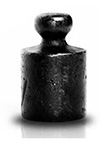
In the wake of the French revolution, France creates the metric system of weights and measures. King Louis XVI’s former jeweller, Marc Etienne Janety, who fled during the revolution, is recalled to Paris to create the standard kilogram weight out of platinum. Platinum is the metal of choice for the task, as its durability means it will not wear away and corrupt the standard. This original platinum cylinder is kept at the International Bureau of Weights and Measures in Paris.
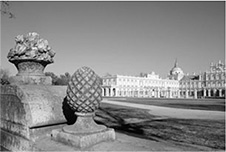
Carlos IV of Spain commissions the creation of a “Platinum Room” at the royal palace in Aranjuez featuring hard wood encrusted with platinum.

British scientist WH Wallaston discovers a process for making platinum malleable, facilitating its commercial use.

Platinum deposits are discovered in the Urals in Russia.

Diamonds are discovered in Kimberley, South Africa.
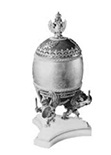
The first of the annual Easter eggs was created by Peter Carl Faberge, jeweller to the Russian Tsars. Each egg was a closely guarded secret, always containing a surprise such as this one with a fully functioning platinum and gold wind up train to celebrate the completion of the Trans-Siberian railway.

Louis Cartier is the first jeweller to successfully create platinum jewellery, revealing the magnificent attributes of the metal and using it to enhance the brilliance of diamonds. Hailed by King Edward VII of England as the “jeweller of kings and the king of jewellers”, royalty and maharajas clamour for Cartier’s creations.
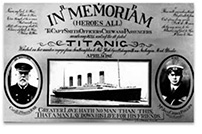
Following the sinking of the world’s largest luxury ocean liner, the Titanic, on her maiden voyage from Southampton, England to New York, New York, society adopts a trend for black and white “mourning jewellery” with platinum being the popular choice of white metal.
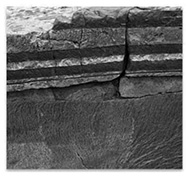
The discovery of the world’s largest platinum deposit near Johannesburg in South Africa by German geologist Hans Merensky gives rise to the modern platinum industry.
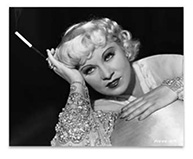
The leading ladies of Hollywood, adorned in platinum jewellery, become a focus for Americans looking to the big screen for escapism during the great depression. The success of platinum in Hollywood is summed up by Jean Harlow’s character in Frank Capra’s movie “Platinum Blonde”.

At the coronation of George VI, his wife Queen Elizabeth (the late Queen Mother) is crowned with an elegant platinum crown holding the famous Koh-I-Noor diamond. King Edward VIII who had abdicated so he could marry divorcee Wallis Simpson exchanges platinum wedding bands made by Cartier. Wallis, now Duchess of Windsor, a collector of jewellery declares platinum the one and only choice for evening wear.
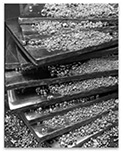
With the outbreak of war in Europe, platinum is declared a strategic metal in the USA and can no longer be used for making jewellery. By 1947 platinum was back in vogue with a number of precious platinum and diamond pieces on display at the “White Heat” exhibition in New York.
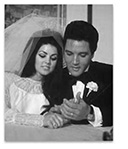
When Elvis and Priscilla Ann Beaulieu marry they exchange platinum wedding rings. The next few decades see the popularity of platinum bridal rings grow in the USA.
Thanks to a remarkable platinum creation, a fairytale became reality when Tanaka Kikinzoku Kogyo of Tokyo, Japan, created a Cinderella shoe using 41/2 lbs (2 kg) of platinum metals. The amazing piece was displayed at the Ideal Home exhibition in the UK and a small gift (sadly not the shoe) was awarded to the woman who fitted the size of the shoe exactly.
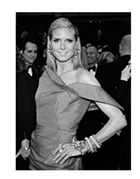
Platinum jewellery causes as great a stir at awards ceremonies as do the stars it adorns. It is the precious metal of choice for the world’s celebrities and notables. Click here to get an insider’s view of platinum on the red carpet!

Ginza Tanaka, Japan produces the world’s most desirable handbag, with a record-breaking value of over £1 million. Made entirely of platinum, and studded with more than 2,000 diamonds, this is one fashion accessory that will stand the test of time.